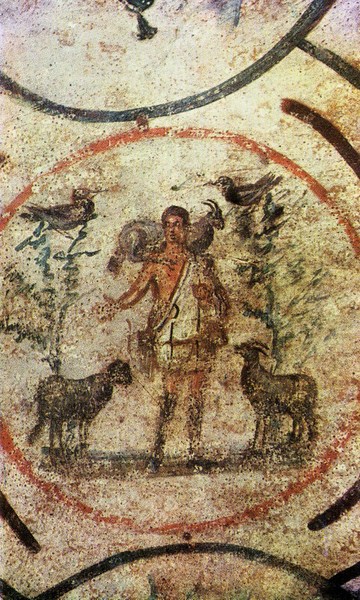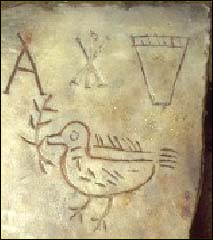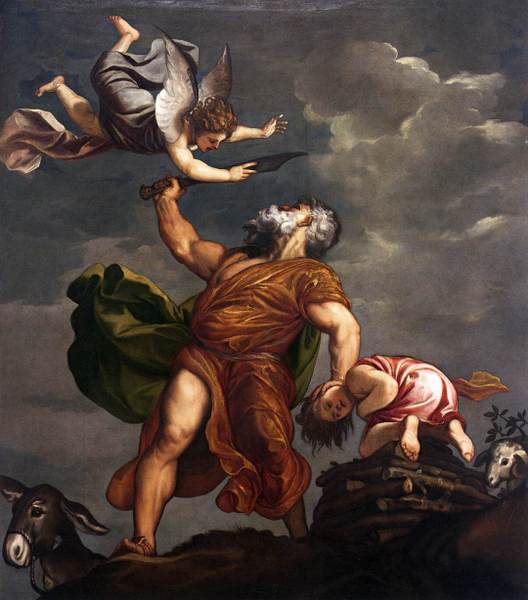Early Christian Art and Artists
The second lesson was a great success. The children answered all the questions Grandmother had prepared, and that good lady was surprised and delighted with the interest shown by them.
After again briefly reviewing the principal parts of the previous lesson, she began the story of Early Christian Art and Artists.
"We will first learn something about conditions in general when Christianity came into the world, "she told the children.
"As you know, the Christian era began with the birth of Jesus Christ" she continued. At that time Rome was mistress of the world. The many independent nations or states that had previously made up the ancient world no longer existed. One after another, they had bowed before the might of the Roman Empire, and paid her tribute. And it was to the city of Rome, the capital of this vast empire, that the conquering armies returned after each succeeding conquest, bringing with them plunder, slaves and hostages.
On those occasions there was great rejoicing in the city and upon the arrival of the victors, the Romans immediately began the erection of an arch or temple to the false Gods of the conquered nations. As a result, Rome became not only the richest city in the world, but also the most beautiful and the most elaborately decorated of all the cities of that time. Her people were mad with the lust for wealth and power, and the entire city was wrapped up in its pleasures and conquests.
But what a change came over the mighty Roman populace upon the advent of Christianity. Their Quests for worldly pleasures were forgotten, and the most brutal persecutions of the unoffending Christians took the place of sports.
The Amphitheatres that had been erected for public games were converted into arenas where those who professed the faith of Christ were tortured and put to death.
But despite all their efforts, Christianity triumphed, and after three centuries during which the Christians suffered the most dreadful persecutions, the mighty Roman Empire that had conquered the world, bowed before God's almighty power. She discarded her false gods and embraced the religion of Jesus Christ, the one true God.
During the long centuries of persecution, the Christians did not give up their faith, but when the Romans would not allow them to practice their religion openly, they excavated underground passages around the city of Rome. It was in these subterraneous vaults that they celebrated mass, buried their dead, and found a haven from the hate and fury of the pagan mob.
These underground vaults are called the "Catacombs" and it is in their depths that we find the works of the early Christian painters.
There are many chapels in the Catacombs that are of great interest to Christians all over the civilized world today because of the paintings with which their walls were decorated. Those paintings are of priceless value although they are crude and lack the perfection of later works. In them we find ornaments and emblems representing the faith of those who worshipped there, for with the advent of the Christian religion, Painting again became symbolic. Many of these emblems are found in our churches today.
St. Augustine, we are told, has called those paintings and symbols "The books of the unlearned," for in the early days of the church the Christians could neither read nor write as we can today, and they learned many of the truths of their religion from the crude mural paintings that adorned the chapels in the Catacombs.
A few of the Christian symbols to be found in the Catacombs are "The Good Shepherd carrying His sheep on His shoulders - A figure of Christ, The Lamb - An emblem of our Saviour and of innocence, The Dove - A symbol of the Holy Ghost and peace and A Ship - A symbol of the Church, the bark of St. Peter."

The Good Shepherd
Catacomb of Priscilla, Rome

The Dove
Catacomb of S. Sebastiano, Rome
There are many other emblems, but those are a few of the principal ones.
The frescoes on the walls of the chapels are very imperfect, for the early Christian Artists did not try to attain perfection. Their one ambition was to move the hearts and minds of the faithful to God. That is why they painted scenes from the Bible. A few of the subjects are "The Sacrifice of Abraham", "Moses striking the Rock", and "Daniel in the Lion's den."
Let us stop for a few minutes and review the stories these pictures tell.

Sacrifice of Isaac. Fresco
Church S. Maria della Salute, Venice, Italy
First "The Sacrifice of Abraham" - In the picture we see Isaac, his hands bound behind his back, kneeling on the wood that is to provide the fire for the sacrifice. Abraham's left hand is placed on Isaac's shoulder while a sword is held in his right hand ready to strike, but an angel stops him. In a bush nearby, a ram is caught ready to take the place of Isaac. Now this is the story as I remember it.
Abraham loved his son Isaac very dearly. One night God, to try Abraham's obedience, commanded him to take his beloved son Isaac and to go up into the mountain and there offer him up for a holocaust. Abraham arose, and having placed wood on the back of an ass, immediately began his journey accompanied by Isaac and two servants. They traveled for three days before reaching Mount Moria, where God had commanded him to offer up the sacrifice. When they arrived in sight of the place, Abraham ordered the servants to rest while he and Isaac would climb the mountain nearby. Then removing the wood from the ass's back he placed it on Isaac's shoulders, and they resumed their journey. Isaac was bewildered and remarked to his father that they were provided with wood for the fire, but had no victim for the sacrifice, but Abraham assured him that God would provide a victim.
When they arrived at their destination, Abraham built an altar upon which he placed the wood, and then bound Isaac and laid his body upon it. Having completed his preparations, he picked up the sword and was about to strike Isaac when an angel touched his arm and told him not to harm the boy, that God was satisfied with his obedience. Abraham obeyed, and upon seeing the ram caught in the bushes, seized it, and offered it as a sacrifice instead of his son. Then the angel told Abraham that God would bless him for the offering he had made and that his posterity would be as numerous as the stars of heaven and the sand that is by the seashore.
Moses Striking the Rock
Catacomb of Sts. Marcellinus and Peter
"Moses Striking the Rock" - While the Israelites were in the desert, there was a scarcity of water, and the people began to murmur against Moses, saying: - "Why didst thou make us go forth out of Egypt, to kill us and our children and our beasts with thirst?" And Moses besought the Lord, saying: - "What shall I do to this people?" Yet a little more and they will stone me."
Then God commanded Moses to take his rod and to go to Mount Horeb and strike the rock. This he did, and immediately water gushed forth in abundance. Then the people quenched their thirst and were satisfied.
In the picture we see Moses striking the rock, the water coming like a falling spring, and some of the thirsty Israelites supplied with the refreshing drink.
Daniel in the Lion's Den
Catacomb of Sts. Marcellinus and Peter
"Daniel in the Lion's Den" - Among the Jews taken captive by the Babylonians was a young man named Daniel; he was of the royal race.
When Cyrus, King of Persia, made himself King of Babylon, he met Daniel and became very much interested in him. Now among the gods adored by the Babylonians was a great dragon, and Cyrus said to Daniel one day, "You cannot say this is not a living god." Then Daniel proposed to kill the dragon without a sword or club. Cyrus agreed to let him try, and Daniel immediately boiled pitch and fat together, and into his mixed hair. Then he rolled the mixture into balls which he placed in the dragon's mouth, and when the Babylonian god swallowed them he burst asunder.
The Babylonians became infuriated over the destruction of their-called god, and demanded that Daniel be delivered up to them. At first Cyrus refused, but finally yielded.
As soon as Daniel was delivered into their hands, they cast him into a den in which seven hungry lions were confined. No food had been given the lions so that they would immediately devour Daniel, but the young man remained unhurt.
After spending six days in the den, Daniel became hungry, and just at that time a prophet named Habacuc, who lived in Jerusalem, had prepared some pottage and was carrying it to the reapers in a field nearby, when he was met by an angel who ordered him to carry the dinner he had in his hands, to Daniel, who was confined in the lion's den in Babylon.
Habacuc told the angel that he had never been in Babylon, and did not know anything about the location of the lions' den. The the angel seizing him by the hair of the head, carried him to Babylon to the den where Daniel was a prisoner.
Daniel ate the dinner, so providentially supplied him, and thanked God who had not forgotten him an his time of need. The angel then carried Habacuc back to the place where he had met him.
On the seventh day the King came to the lions' den, and was astonished when he saw Daniel sitting quietly in the midst of the seven hungry lions. He immediately ordered his release and his persecutors were thrown into the den. Before their bodies reached the ground, they were torn to pieces and devoured by the hungry beasts.
When Cyrus saw this, he published an edict commanding all his subjects to fear and venerate the God of Daniel, for he is the Savior, working signs and wonders in the earth; Who hath delivered Daniel out of the lion's den".
In the picture we see Daniel sitting in the midst of the wild beasts calm and unconcerned.
So you see children that although the early christians could not read the bible, they experienced little difficulty in studying the most important parts of the Old Testament by reading the pictures on the walls of the Chapels in the Catacombs. That is why St. Augustine called those paintings "The books of the unlearned."
During the reign of Constantine (306-337), Christianity became the national religion and the faithful were no longer compelled to worship God secretly in the recesses of the Catacombs. Churches were erected and Christian Art began to show itself in the light of day in the form of mosaics and other church decorations.
Byzantine Art
Then Constantine moved the seat of government from Rome to Byzantium (Constantinople), and this city became the center of the Christian World. In this new setting, Christian Art soon began to register the influence of the orient by which it was surrounded. The art, produced from AD 330 until the fall of Constantinople in 1453, is known as Byzantine Art.
During the 11th century, schools were established and their influence extended to Western Europe through the medium of the crusaders. It was after this period that Byzantine art(?) began to decline.
Paintings of the Byzantine period were of the Mosaic Type. Highly colored glass, marble and stone were used lavishly in those pictures, and the figures in them were place against backgrounds of bright blue and gold so that the effects were striking. The figures, however, did not possess beauty of face or form, the artist's aim being to bring out the spiritual rather than the physical beauty of the figures. the faces were long, the expressions melancholy, and the entire figures stiff and unnatural. Italian painters tried to break away from the Byzantine influence, but it took centuries of untiring effort to accomplish even a slightest change in the Byzantine style.
It was in the thirteenth century that a decided improvement was brought about and the figures began to look more natural, and this is how it came about.
Use of Live Models
Up to this time, living models had not been used by any of the painters of the Christian Era. When an artist decided to paint a picture, he simply looked up some earlier production that had appealed to him and used the figures portrayed therein as models. The result was unnatural and depressing, for it certainly could not appeal to the beholder.
As a consequence, art in Italy was on the decline, and Italian artists looking about to learn the reasons for this condition, began to realize that perfection in painting could never be attained while artists looking about to learn the reason for this condition, began to realize that perfection in painting could never be attained while artists used the figures presented in Byzantine pictures for their models.
They finally concluded that if painters were to realize their ambitions and produce perfect pictures, they must first have perfect models to copy from, and the Byzantine works did not afford any good examples for imitation. Only the work of God's hands alone could furnish artists with the perfection they hoped to reproduce in their pictures with the aid of brushes and colors, and in order to accomplish this, the models would have to be selected from God's creations, either members of the human family or landscape that would appeal to the individual painter. With this knowledge to guide them in their efforts, artists soon began to ignore the Byzantine ideals that had governed their works for centuries, and a decided change for the better was apparent in their productions.
Giovanni Cimabue was the first great painter of the Christian era, and we will now see how much we can learn about him.
| Page 4 | Beginning of Book | Page 6 |